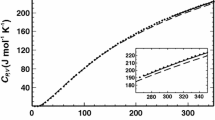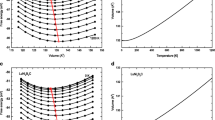Abstract
The thermoelastic properties of the thermoelectric chalcogenide galena, lead sulfide (PbS), have been determined in the temperature interval 10–350 K from high resolution neutron powder diffraction data, and literature values of the isobaric heat capacity. Within this temperature range, galena can be described by a simple phenomenological model in which the cation and anion vibrate independently of one another in a Debye-like manner, with vibrational Debye temperatures of 120(1) K for the lead, and 324(2) K for the sulfur. Simultaneous fitting of the unit cell volume and the isochoric heat capacity to a two-term Debye internal energy function gives characteristic temperatures of 110(2), and 326(5) K in excellent agreement with the measured vibrational Debye temperatures derived from fitting the atomic displacement parameters. The thermodynamic Grüneisen constant derived from the isochoric heat capacity is found to monotonically increase with decreasing temperature, from 2.5 at 300 K, to 3.25 at 25 K, in agreement with the deductions of earlier work. The full phonon density of states calculated from the two-term Debye model shows fair agreement with that derived from density functional theory.








Similar content being viewed by others
References
Anderson CT (1932) The heat capacities at low temperatures of the sulphides of copper and lead. J Am Chem Soc 54:107–111
Barron THK, White GK (1999) Heat capacity and thermal expansion at low temperatures. Kluwer Academic, New York
Božin ES, Malliakos CD, Souvatzis P, Proffen T, Spaldin NA, Kanatzidis MG, Billinge SJL (2010) Entropically stabilized local dipole formation in lead chalcogenides. Science 330:1660–1663
Braun F (1874) Ueber die Stromleitung durch Schwefelmetalle. Ann Phys Chem 200:556–563
Cardona M, Kremer RK, Lauck R, Siegle G, Serrano J, Romero AH (2007) Heat capacity of PbS: isotope effects. Phys Rev B 76:075211
Chattopadhyay T, Von Schnering HG, Grosshans WA, Holzapfel WB (1986) High pressure X-ray diffraction study of the structural phase transitions in PbS, PbSe and PbTe with synchrotron radiation. Phys B 139&140:356–360
Eastman ED, Rodebush WH (1918) The specific heats at low temperatures of sodium, potassium, magnesium and calcium metals, and of lead sulphide. J Am Chem Soc 40:489–500
Elcombe MM (1967) The crystal dynamics of lead sulphide. Proc R Soc Lond Ser A 300:210–217
Fan D-W, Zhou W-G, Wei S-Y, Liu J, Li Y-C, Jiang S, Xie H-S (2010) Phase relations and pressure–volume–temperature equation of state of galena. Chin Phys Lett 27:086401
Fizeau H (1868) Sur la dilatation des corps solides par la chaleur. CR Acad Sci 66:1005–1014
Flowers AE (1909) Crystal and solid contact rectifiers. Phys Rev 29:445–460
Grzechnik A, Friese K (2010) Pressure-induced orthorhombic structure of PbS. J Phys: Condens Matter 22:095402
Hagni RD (1986) A summary of the geology of the ore deposits of the tri-state district, Missouri, Kansas, and Oklahoma. A guidebook to the geology and environmental concerns in the tri-state lead-zinc district, Missouri, Kansas, and Oklahoma, Association of Missouri Geologists, 33rd Annual Meeting, 30–54. http://missourigeologists.org/EarlierGuidebooks/Guidebook1986.pdf
James RW (1962) The crystalline state volume II: the optical principles of the diffraction of X-rays. G Bell and Sons, London
Kanatzidis MG (2010) Nanostructured thermoelectrics: the new paradigm? Chem Mater 22:648–659
Kastbjerg S, Bindzus N, Søndergaard M, Johnsen S, Lock N, Christensen M, Takata M, Spackman MA, Iversen BB (2013) Direct evidence of cation disorder in thermoelectric lead chalcogenides PbTe and PbS. Adv Funct Mater 23:5477–5483
Keiber T, Bridges F, Sales BC (2013) Lead is not off center in PbTe: the importance of r-space phase information in extended x-ray absorption fine structure spectroscopy. Phys Rev Lett 111:095504
Knight KS (2012) Low temperature thermoelastic and structural properties of LaGaO3 in the Pbnm phase. J Solid State Chem 194:286–296
Knight KS (2014) A high-resolution neutron powder diffraction investigation of galena (PbS) between 10 K and 350 K: no evidence for anomalies in the lattice parameters or atomic displacement parameters in galena or altaite (PbTe) at temperatures corresponding to the saturation of cation disorder. J Phys: Condens Matter 26:385403
Knight KS, Bonanos N (2013) Thermoelastic and structural properties of ionically conducting cerate perovskites: (I) BaCeO3 at low temperature in the Pbnm phase. Solid State Ionics 232:112–122
Knorr K, Ehm L, Hytha B, Winkler B, Depmeier W (2003) The high-pressure α/β phase transition in lead sulphide (PbS). Eur Phys J B 31:297–303
LaLonde AD, Pei Y, Wang H, Snyder GJ (2011) Lead telluride alloy thermoelectrics. Mater Today 14:526–532
Larson AC, Von Dreele RB (1986) General structure analysis system (GSAS), Los Alamos National Laboratory Report LAUR 86-748
Lykov SN, Chernik IA (1982) Specific heat of lead chalcogenides. Fiz Tverd Tela 24:3102–3105
Noda Y, Masumoto K, Ohba S, Saito Y, Toriumi K, Iwata Y, Shibuya I (1987) temperature dependence of atomic thermal parameters of lead chalcogenides, PbS, PbSe and PbTe. Acta Cryst C43:1443–1445
Novikova SI, Abrikosov NK (1963) Investigation of the thermal expansion of lead chalcogenides. Fiz Tverd Tela 5:1913–1916
Padaki VC, Lakshmikumar ST, Subramanyam SV, Gopal ESR (1981) Elastic constants of galena down to liquid helium temperatures. Pramana 17:25–32
Parkinson DH, Quarrington JE (1954) The molar heats of lead sulphide, selenide and telluride in the temperature range 20 K to 260 K. Proc Phys Soc London, Sect A 67:569–579
Ravich YI, Efimova BA, Smirnov IA (1970) Semiconducting lead chalcogenides. Springer, New York
Reif F (1965) Fundamentals of statistical and thermal physics. McGraw-Hill, New York
Romero AH, Cardona M, Kremer RK, Lauck R, Siegle G, Serrano J, Gonze XC (2008) Lattice properties of PbX (X = S, Se, Te): experimental studies and ab initio calculations including spin–orbit effects. Phys Rev B 78:224302
Samara GA, Drickamer HG (1962) Effect of pressure on the resistance of PbS and PbTe. J Chem Phys 37:1159–1160
Sharma SS (1951) Thermal expansion of crystals part VIII galena and pyrite. Proc Indian Acad Sci A34:72–76
Sirdeshmukh DB, Deshpande VT (1973) X-ray determination of thermal expansion of lead sulphide. Indian J Pure Appl Phys 11:366
Smith GD, Firth S, Clark RJH, Cardona M (2002) First- and second-order Raman spectra of galena (PbS). J Appl Phys 92:4375–4380
Snyder GF, Toberer ES (2008) Complex thermoelectric materials. Nat Mater 7:105–114
Stefan J (1865) Ueber einige Thermo-Elemente von grosser elektomotischer Kraft. Ann Phys 229:632–635
Toby BH (2001) EXPGUI, a graphical interface for GSAS. J Appl Crystallogr 34:210–213
Wakabayashi I, Kobayashi H, Nagasaki H, Minomura S (1968) The effect of pressure on the lattice parameters Part I. PbS and PbTe Part II. Gd, NiO, and α-MnS. J Phys Soc Jpn 25:227–233
Wallace DC (1972) Thermodynamics of crystals. Wiley, New York
Wood IG, Knight KS, Price GD, Stuart JA (2002) Thermal expansion and atomic displacement parameters of cubic KMgF3 perovskite determined by high-resolution neutron powder diffraction. J Appl Crystallogr 35:291–295
Acknowledgments
I am grateful to the comments from two anonymous reviewers that have led to improvements in the manuscript and to Prof. Milan Rieder for editorial assistance. My colleagues Jon Taylor, William David, Alex Hannon and Matthias Gutmann are thanked for the many discussions concerning the structural properties of lead chalcogenides. I am indebted to Prof. Manuel Cardona (Max-Planck-Institut für Festkörperforschung) for providing the calculated full, and partial, phonon density of states function for galena.
Author information
Authors and Affiliations
Corresponding author
Rights and permissions
About this article
Cite this article
Knight, K.S. Low temperature thermoelastic properties of galena in a simple, self-consistent, two-term Debye model. Phys Chem Minerals 42, 235–242 (2015). https://doi.org/10.1007/s00269-014-0714-9
Received:
Accepted:
Published:
Issue Date:
DOI: https://doi.org/10.1007/s00269-014-0714-9




